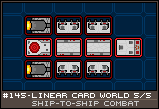| Three Hundred |
| - Index Page |
| - About... |
| - By Year |
| Collections |
| - Comp-Grid |
| - Procedural |
| - Tactics |
| - Tiny Crawl |
| - Misc |
| Previous | Mechanic #145 | Next |
![[experiment.png]](set08/img/entry141-experiment.png)
I'm doing a little experiment over the next few entries. I'm going to take a single structural mechanic and I'm going to build five different game concepts around it. For this experiment, the mechanic I have chosen is: A world map based on a series of cards laid end to end in a linear manner. Each card represents a room, which can contain pawns, chits, or markers representing game objects. There is no y-axis, at least in the typical concept of two-dimensional maps, making this a more restrictive mechanic than something like [#124 - Card Metroidvania].
![[ship1.png]](set08/img/entry145-ship1.png)
This one is a bit complicated, but the just of it is that you have two spaceships that are fighting in the depths of space. You don't control the ships directly, but instead control the crew members who control the ships. For instance, if you want your ship to move forward, you need a crew member on the bridge to active the controls. The ships themselves are not static. They are built along a linear backbone that allows you to wiggle the ship like a snake, shifting rooms from one column to the other. You can also collect resources that you can use to build additional rooms onto your ship. And some rooms can move independently away from the ship, such as shuttles, allowing you to board the enemy and bring the fight to him.
There are five crew members, chosen from three classes: security, engineering, and command. Each class allows them to do different things on the ship. For instance, Command Crew can pilot the ship, shuttles, and can improve the capabilities of the other classes in the same room. Engineer Crew can repair damaged rooms, build new ones, or collect energy resources in the engineer room. And Security Crew excels at combat, both interpersonal and firing the ship's laser canons. Each crew member has two actions per turn, allowing them to move, fight, or activate a command in a specialty room. The Engine Room, for example, has three different types of resources (time, energy, ingenuity), and an engineer can choose to use an action to collect one of them. He can use two actions to collect two resources, both of the same type or different. Two engineers can collect up to four resources per turn, though engineers are also needed throughout the ship to repair damaged rooms or build new ones. Command Crew on the bridge can pilot the ship to move up, down, left, right, or rotate 180 degrees. Two Command Crew can cause this to happen four times in a single turn. You can use this to get the ships closer together, or even ram them into each other. When two ships are touching, crew members can breach into the other ship for interpersonal combat.
![[ship2.png]](set08/img/entry145-ship2.png)
A ship is built along a single, linear backbone. It starts with the bridge and runs back to the engineer room. It is through this backbone that the ship can transform and change shape.
![[ship3.png]](set08/img/entry145-ship3.png)
Each column of the ship can be moved up or down by a crew member. Shifting may occur as lone as the center line, from bridge to engine room, is maintained. Should a card in this line be destroyed, breaking the backbone, everything on the side without the engine room is destroyed and the crew members in it lost.
![[ship4.png]](set08/img/entry145-ship4.png)
You can also shift rooms from one column to the other. If you shift a room that is not the outermost room, all rooms above it will move close to the ship's backbone. If you have enough actions, you can move more than one card at a time, such as moving two cards in a column over without them dropping or rearranging between each shift. Is is though this shifting that you can manipulate your ship's make up to best suit your needs. As you fight, rooms will be destroyed. Or the two ships will change positions relative to each other, exposing a weak spot. Or you can just use shifting to move crew members around easily.
![[ship5.png]](set08/img/entry145-ship5.png)
If you can manipulate your shape to increase the points of contact between the two ships, you can increase the amount of damage done while ramming, or increase the number of breach points to attack from. You opponent must repair all breach points before it can disentangle, so the more places you attach yourself, the more difficult it will be to detach.
![[ship6.png]](set08/img/entry145-ship6.png)
Building is relatively straight forward. Send an engineer to an edge room and, if you have the resources, select a room and append it to the end. One special room, the girder structure, allows you to insert it between rooms. You can then build a room on top of the girder structure, or you can shift rooms into the space occupied by it. Once it is covered by a room, it is destroyed. So shifting the room afterwards would cause the outermost rooms to contract once again.
![[ship7.png]](set08/img/entry145-ship7.png)
Finally, there is the shuttle. It is a room that can be piloted away from the starship by a Command Crew to take crew members over and dock with the enemy ship. It can only leave if it is the outermost room on a column, so if it is interior at any point (perhaps to protect it from enemy canon fire while it is being built), it will need to be shifted out before it can take off.
|
